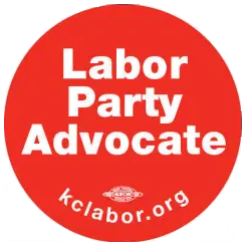It’s Time for a New Political Party!


Originally published on 10/5/2019
By Labor Fightback Network
With each passing year, elections in the United States have been increasingly insulting of working people’s intelligence. To be sure, the politicians have never had much respect for the people who vote them into office. During every election campaign season, the voters are subjected to a chorus of personal attacks. Meanwhile, with each passing month, working people are facing more difficulties paying to keep a roof over our heads and the choice of paying for prescription medicines or food, difficulties which have increased exponentially since the economic crash of 2008.
We look to the elected officials — or those who would take the place of the elected officials — for answers, and all we hear is the same old drivel.
In 2016 working voters are fed up to the teeth, and they are unleashing their anger on the political elites of both major political parties.
The Democratic Party seemed poised to give former Secretary of State Hillary Rodham Clinton a coronation, with little or no opposition as the campaign for the nomination began in 2015. In that context, the independent Vermont Senator Bernie Sanders made a decision to challenge her in the Democratic nomination process. What happened next was completely contrary to all expectations. The 74-year-old self-described socialist ran a campaign not about how wonderful Bernie Sanders would be as President, but about a single-payer national health plan, stopping the Trans-Pacific Partnership trade agreement, a tax plan to make the richest pay “their fair share,” and a call to break up the big financial institutions, arguing that “too big to fail” is too big to be in business. He ran a campaign on the issues and called for change, and the people responded.
A funny thing happened: Sanders gave Secretary Clinton a run for her money. He fought her to a tie in the Iowa caucuses and beat her decisively in the New Hampshire primary. The states that Clinton won were states where the Democratic Party had strong urban political machines which could turn out the vote for the leadership’s favored candidate. Even so, as e-mail messages that were exposed by the Wikileaks website on the Internet have shown, the Democratic National Committee violated its responsibility to be neutral and took whatever undemocratic steps it could to ensure Clinton’s victory.
Sanders could not prevail in an undemocratic Democratic Party. Though the voters in large numbers rejected establishment politics, it was establishment politics that ultimately won, and Secretary Clinton became the nominee, choosing a nondescript conservative, Senator Tim Kaine of Virginia, as her running mate.
If the Democratic nomination campaign was unusual, the Republican campaign was downright bizarre.
A huge field of candidates initially sought the Republican nomination, from well-established senators and governors, like incumbent Governor Chris Christie of New Jersey, Texas Senator Ted Cruz, and Florida Senator Marco Rubio. Two business executives who had never before held elective office also sought the nomination: former Hewlett-Packard Chief Executive Officer Carly Fiorina and New York real estate developer Donald Trump.
The conventional wisdom was that a third member of the Bush dynasty would be nominated to face off against the second of the Clinton dynasty. Senators Cruz and Rubio and Governor Christie were also considered possibilities. But the Republican voters had a different idea.
For decades Republican politics has been strongly influenced by hateful radio and Fox News talk show hosts such as Rush Limbaugh, Glenn Beck, Bill O’Reilly, and Sean Hannity, along with reactionary preachers such as Pat Robertson and the late Jerry Falwell.
Trump proved to the Republican Party St. Paul’s warning (Galatians 6:7): “Whatsoever a man soweth, that shall he also reap.” Years of racist, sexist, and hateful lies had sufficiently eroded the political discourse within the Republican Party that the most outlandish and groundless conspiracy theories found a sympathetic hearing among Republican voters. But something else was happening, too. The economic uncertainty that attracted Democratic voters to the anti-establishment candidate Bernie Sanders attracted Republican voters to the anti-establishment Donald Trump. His completely unworkable and even unconstitutional proposals, such as building a wall along the Mexican border to keep “illegal aliens” out (and making the Mexican government pay for it) and excluding all Muslims from entering the United States “until we can figure out what the hell is going on,” struck a sympathetic chord with older working-class white males. Even if they understood that Trump’s proposals would never work, but they appreciated his anti-elitism.
Contrary to all expectations, Trump blew the establishment candidates out of the water. Even when the Republican leadership brought in the “big guns” — including former President George W. Bush and 2012 Republican nominee Mitt Romney — it was not nearly enough. All of the accusations against Trump — that he was a dishonest “con artist,” that he was not qualified for the job as President, that his policy proposals were completely unworkable, and many more — are all true. The Republican voters seemed not to care. Trump ran away with the nomination.
In polling, both Clinton’s and Trump’s disapproval ratings exceed their approval ratings; Trump’s net disapproval exceeds Clinton’s. It is clear that in 2016 the voters will be voting against a candidate rather than for a candidate, and the campaigns are reflecting the negativity, as Trump rants about “Crooked Hillary,” and Clinton counters with “Dangerous Trump.” It’s the same old political game, and American working people are sick of it.
If there was ever an opportunity for an electoral alternative to Big Business’s twin parties, it is staring us in the face, right now.
Unfortunately, the leadership of the labor movement, of the African-American community and other Communities of Color, and even challenger candidate Senator Bernie Sanders, have chosen the route of “defeat Trump at all costs” and are calling on working people to vote for Secretary Clinton. Polls have indicated that while most Sanders voters will likely vote for Clinton; the campaign activists, those who phone-banked, canvassed, and fund-raised for Sanders, are not coming around to support Clinton in the numbers that the Democratic leaders had hoped. It was visible at the Democratic convention in Philadelphia, where anti-Clinton street marches brought together hundreds of people, including Sanders delegates who had walked out of the convention. The Democratic National Committee did its best to stage-manage its convention so that those protests were invisible, but they had limited success.
The largest independent electoral initiative — not counting the right-wing Libertarian Party — is the Green Party, whose candidates are Dr. Jill Stein for President and Ajamu Baraka for Vice President. Various polls show Green support at between four and eight percent, considerably higher than the support that the Green Party received in 2012. Any social-justice trade unionist would react favorably to the Green Party’s platform. It is broadly pro-labor; it supports racial justice — including Black Lives Matter; it opposes hydraulic fracking for fossil-fuel extraction, as well as nuclear power for generating electricity. It opposes war and U.S. intervention into the affairs of other countries — and includes opposition to the continued Israeli occupation of Palestinian Arab territory.
This platform was developed by good people who got together on this programmatic basis, and there is nothing inherently wrong with that. But what we need today is a political party that represents the organized working class, through their own organizations, the trade unions. It is up to social-justice-minded trade unionists to fight within the unions for the perspective of a new political party, rather than trying to use one of the big business parties in a vain attempt to win a few concessions. The Green Party and other independent electoral alternatives can and must be a part of the process of developing the massive party that is so desperately needed. Dr. Stein herself set a good example during July when she invited Senator Sanders to join the Green ticket (imagine if he had agreed!). The Communities of Color, and especially the Black Lives Matter movement, are indispensable to the independent political action that is needed, as are the hundreds of thousands of young people who flocked to the Bernie Sanders campaign and are now feeling betrayed and disillusioned.
The strategy of relying on the Democratic Party to represent the interests of working people and our community allies has again proved to be a losing strategy. A united effort by the social-justice wing of the labor movement, by the Black, Latino, Native American communities and other Communities of Color, by the young, by women, and by the Lesbian, Gay, Bisexual, Transgender, and Queer communities, to forge a new political party which can represent the 99% in upcoming elections is on the immediate agenda. It’s going to take us all.

